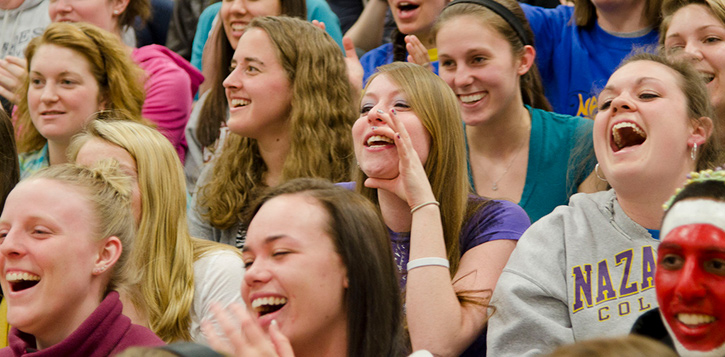Is There Still a Need for Women’s Colleges?
Although still the minority in many degree plans, women generally earn their degrees in higher numbers than men. In the 2009-2010 school year, they actually earned the majority of degrees at every level: 62% of associate, 57.4% of bachelor’s, 62.6% of master’s, and 53.5% of doctorates land in the hands of the ladies. Those numbers have been steadily building over time, too, with doctorates seeing the biggest bump between the 1990s and now. Which poses the question — now that female students dominate the co-ed classroom, how are traditionally all-women’s colleges adapting? Is there still a place for them? Originally conceived to provide equitable educational opportunities for scholars marginalized along gender lines, how are they staying relevant now that the glass ceiling keeps cracking?
The Numbers
Although women have made inroads in almost every academic discipline, some programs remain stratified. Women only make up 39% of MBA applicants (though they’re getting better), and they consistently lag behind when it comes to pursuing the male-dominated science, technology, engineering, and mathematics (STEM) fields. Around 2.5 million women with degrees in STEM areas work in these industries, compared with 6.7 million men. Involvement in a women’s college might very well prove beneficial to closing up this egregious gender gap, and they are banding together and bulwarking themselves to ensure a future workforce battalion of veritable Rosie the Riveters.
Forty-seven American and Canadian institutions belong to the Women’s College Coalition. The organization represents roughly 85,769 students, 80,352 (93.7%) of them female. But their numbers have been declining alongside the inclining population of women on other campuses; in the 2004-2005 school year, 90,402 students opted for women’s colleges. That dip, however, doesn’t mean that these institutions are headed toward extinction. There are still plenty of reasons to explore women’s colleges as an option, particularly when it comes to honoring the objectives around which they were founded — lessening the gender gaps and ensuring the safest, healthiest, most supportive spaces where women can learn.
The Case for Women’s Colleges
Safety may propel some female students to pursue educational opportunities at women’s colleges. Although many of these institutions now controversially accept a few men, their curricula and main goals still revolve around meeting the unique needs of their female enrollees. An average of one rape per day happens on campus at traditionally and explicitly co-ed facilities, and 13% of female students are stalked at some point during the school year. Since 90% of incidents are perpetuated by people they know — most of them men — it isn’t as if they fear the stereotypical random boogeyman jumping out of the bushes. It makes sense that some women would gravitate towards environments that significantly lessen (though, sadly, not entirely eliminate) their risk of physical assault. Seventy-two percent of women’s college alumni report feeling safe on campus, compared with 64% at private and co-ed liberal arts institutions and only 37% at flagship state schools.
Women’s colleges launched primarily to close the gap between the number of men and woman on campus. Although more women now receive degrees than men, gulfs still exist in many degree plans, but women’s colleges already possess the know-how necessary to continue tackling inequality issues. October 2012 saw 24 promising female undergraduates (12 American, 12 international) receive scholarships to major in STEM fields, thanks to the NeXXt Scholar initiative. It wasn’t a coincidence that the eight schools selected to participate are ones that traditionally and explicitly cater to the needs of women students.
Similar programming exists to increase the number of women with MBA degrees as well. At Simmons College in Boston, Massachusetts, for example, their School of Management specifically incorporates women’s issues into the syllabi. As a traditionally female-oriented campus, it understands the problems experienced by businesswomen once they enter the workforce – especially at the management and executive levels. Graduates exit the program with awareness of what they might witness upon launching their careers, making the challenges far easier to navigate. More opportunities to study in comparatively “customized” classrooms mean more opportunities for the ladies to start conquering higher and higher levels of the male-dominated corporate world.
Even beyond these obvious perks, graduates from traditionally women’s colleges have plenty of other reasons to consider them wholly viable options. Eighty-seven percent of graduates from these institutions complete their degrees in four or fewer years; compared with 79% of their counterparts at private, co-ed liberal arts schools and just 54% in flagship public universities. When it comes to broadening their perspectives and skill sets, they also maintain a significant lead, with 69% of all graduates participating in extracurricular activities and 74% involved with volunteer initiatives. Eighty-one percent leave feeling fully prepared for the work force. Perhaps most significantly, 72% declare themselves “completely satisfied” when it comes to the overall quality of their educational experiences – once again, more than their counterparts at other colleges and universities.
Those numbers cannot go ignored. Women’s colleges yield some incredibly successful results when it comes to producing happy, thriving, and well-rounded students. Former Secretary of State Hilary Clinton is a Wellesley alum, for example. To de-emphasize these schools in favor of traditionally co-educational campuses would be to deny female students opportunities that might work best for their personal and professional needs. Students autonomously decide which environment suits them snuggest, not vice-versa. If women’s colleges and female-majority co-ed schools were in fact interchangeable, the statistics would reflect this. Reality shows that the higher education sector possesses room for both female-majority schools and women’s colleges.
Changing With the Times
As with other higher ed institutions, women’s colleges succeed when they adapt themselves to new technologies and trends rather than stubbornly clinging to the obsolete. Schools participating in the NeXXt Scholars Program must especially embrace change. Without an openness to the very innovations that make the STEM fields what they are, female students hoping to narrow the disconcerting gender gulf will be denied the necessary training. Fortunately for them, these colleges don’t seem any more or less resistant than their co-ed contemporaries.
Such scholarship programs are helpful for aspiring students. Seventy-four percent of students who enroll in women’s colleges earn scholarships or grants, just under the 76% for private liberal arts schools. Although 93% report feeling their student loans proved well worth the investment, 68% applied in order to afford their educations; contrast this with 58% for liberal arts colleges and 43% for public schools. With such a price tag, many individuals exploring the possibility of attending women’s colleges might think themselves locked out, which makes scholarships and other educational advancements crucial.
One of the most recent examples involves, of course, the ubiquitous MOOC. Short for “massive online open course,” the amalgamation of Internet-based classrooms and opencourseware rocketed to prominence in 2012. Wellesley, best known as a liberal arts institution, garnered a fair amount of attention when it partnered with the edX initiative. This marked the very first time a traditionally women’s college decided to start offering MOOCs, and the first liberal arts school to work with edX. Such an unexpected, though welcome, move came about for the same reasons expressed by other institutes of higher learning. Because of mounting enrollment demands, Wellesley harnesses MOOCs to ensure students land spots in the most popular courses. This helps them save time by not falling behind on prerequisites and other classes that fill up quickly – and saving time means saving money as well. Seeing as how 68% of enrollees sought grants, scholarships, and loans afford their educations, any cost-cutting measures that could reflect in tuition prices would obviously be welcome.
“According to our Chief Information Officer, Ravishanker Ganesan, one of the most significant steps we’ve taken is to ‘establish a formal position, Director of Emerging Technologies, whose job it is to follow the emerging technology trends and bring them to the faculty to see what might work to support our curriculum,'” explains Anne Yu of Wellesley’s Communication and Public Affairs Team, regarding the school’s future adaptations. She notes that computer science stands as the 10th-most-popular major at Wellesley, so these changes greatly behoove their students and the very future of women in STEM alike. Other forward-thinking plans include “several interesting Digital Humanities projects,” a library that “follows leading edge trends involving the shift to electronic media,” “several faculty & students in the sciences who are doing advanced research using high performance computing clusters,” and the “Library and Technology Services team is also collaborating with faculty and students in Computer Science to jointly develop interesting Mobile Applications.”
Despite the mounting levels of female students receiving degrees at traditionally male-dominant institutions, women’s colleges ought not go dismissed. They still offer myriad benefits to enrollees, particularly when it comes to safety as well as opportunities in more gendered degree plans and career paths. With initiatives like NeXXt and the edX partnership, women’s colleges remain both relevant and entirely devoted to their original causes. And the greater sense of safety, community, and overarching satisfaction make cases for their survival, too. All of these qualities render them wholly valid options, especially for students hoping to dedicate their lives to shattering the glass ceiling and opening up even more chances for future generations.
How to Pick the Right One for You
The Women’s College Coalition fully outlines what students considering a single-sex or traditionally female campus should keep in mind while hunting for a school. Finding the right fit means looking at available degree plans, housing options, campus support structures (non-traditional student outreach, career counseling, tutoring, etc.), extracurricular opportunities, size, location, and numerous other factors. Those who prefer higher degrees of campus engagement and smaller class sizes might especially thrive in women’s college environments.
The following tips need to be kept in mind when researching women’s colleges:
- Think about your degree plan. Search which schools offer which programs, and the faculty (always research the faculty) specialties. Although many of the women’s colleges out there hold renown as liberal arts institutions, STEM is quickly expanding in popularity. If one of those fields sounds more appealing, find a school opening up about their efforts to provide more opportunities for women in science, technology, engineering, and math.
- Figure out your learning style. Factors like class size, co-educational campuses, access to online or blended options, opportunities to travel, accessibility, challenges, and more all filter into the college search. Working with a guidance counselor at your high school will help you discover which environments prove most conducive to your educational needs. And don’t be afraid to reach out to schools and ask questions. Admissions professionals, administrators, and maybe even some faculty members are willing to proffer advice and answer inquiries about what to expect in their classrooms.
- What appeals to you, personally, about women’s colleges? It might be the comparative safety. It might be the extracurricular activities. It might be the emphasis on closing the gender gap in STEM. It might be something else entirely. Women’s colleges are pretty unique, and appeal to certain academic desires. Before applying, explore the broad appeal of these institutions. Start looking for a more specific institutional fit after that. The Women’s College Coalition website provides some excellent resources for students considering the eponymous educational options.
- Get your financial aid in order. As stated previously, 68% of women’s college enrollees required scholarships, grants, and loans to fund their classes – more than their counterparts at any other type of school. Because of this, applicants seriously need to take their finances into consideration when choosing the right fit. Most pressing? Whether they want to tackle that debt after graduation. Even if everything about a school proves ideal, it might come to pass that for some students, the expenditures involved might not be realistic.
- Consider your extracurriculars. Women’s colleges report higher levels of extracurricular activities and campus engagement than any other school types. Some students might find this enticing, whereas others consider it a dealbreaker. Applicants falling in the former category must research what schools offer what activities outside the classroom. If everything else, including finances, works, would they be willing to make sacrifices for a school that may not offer what they want in terms of clubs, sports, etc.? This is especially important when it comes to networking opportunities for future careers, like organizations supporting women in STEM.
- Research campus support. Some students need tutors, mental health professionals, career counselors, and other support structures. Schools without these perks would be right out, so it’s best to check what all they offer ahead of time. The more Internet-savvy applicants out there might want to post on forums and social media asking current and former students about their experiences.
Female students may make up the majority of degree recipients these days, but that doesn’t women’s colleges should be dismissed as obsolete. Their objectives regarding equal footing for a traditionally marginalized demographic remain relevant, particularly when it comes to the STEM fields. But even for aspirant enrollees, these schools provide other excellent perks, like more engaged environments, increased safety, volunteer opportunities, and more. Different students require different things, so the relevance of women’s colleges remains the same as it ever was.











